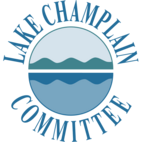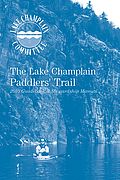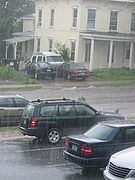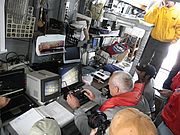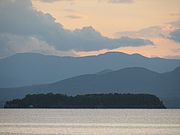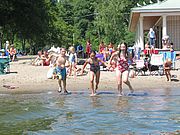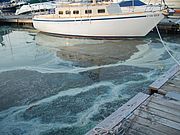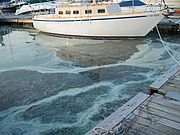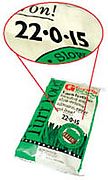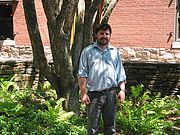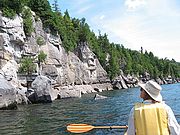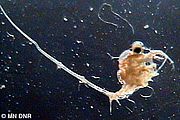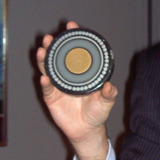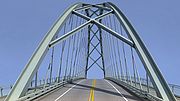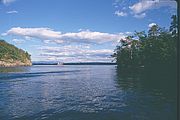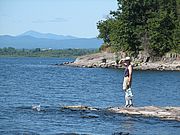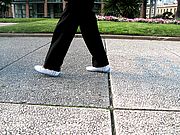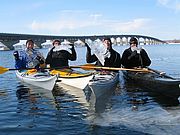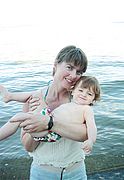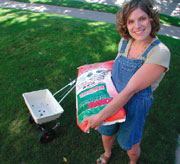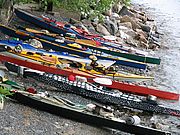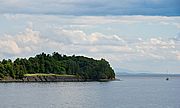Get your copy by joining LCC or renewing your membership!
The 2010 edition of the Lake Champlain Paddlers' Trail Guidebook and Stewardship Manual is out! It’s jam-packed with important information for great adventures on the water including site descriptions and chartlets for 39 Trail locations (including several new sites!), launch site listings, natural history articles...
Read...
The Nature Conservancy (TNC) recently released a report titled “Climate Change in the Champlain Basin: What natural resource managers can expect and do,” one of the first efforts in North America to assess climate change on a watershed scale and offer adaptation strategies. LCC Staff Scientist Mike Winslow served as a reviewer on the report... Read...
On June 15th, a team with representatives from the EPA, Lake Champlain Maritime Museum, the McAllister Company and Phoenix Engineering conducted an observation of the sunken tugboat William H. McAllister. The team used a remotely operated submersible vehicle to search...
Read...The Department of Energy has determined that an Environmental Impact Statement (EIS) will be required... Read...
Algae blooms on Lake Champlain have calmed down since early July when a heat wave triggered blooms from Charlotte to Port Henry. Sampling done by LCC monitors during the week of July 26th reported no blooms in the northern lake, Missisquoi Bay, the Main Lake, or... Read...
Our blue green algae monitoring program got underway this week with citizen monitors taking samples at 18 shoreline locations. The current hot, steamy weather conditions are ideal for algae growth and they’ve led to extensive algae blooms particularly in Addison (VT) and Essex (NY) counties. Blooms have been reported in many areas from Burlington south to the Crown Point Bridge area, including Port Henry, Westport, Panton, Ferrisburgh, Kingsland Bay, Long and Thompson’s Points, around Juniper Island in the Main Lake and other locations. Shifts in wind and water currents will move the blooms around the lake and scums may accumulate on the shoreline so keep a watch on the water.... Read...
The hot steamy weather has led to reports of extensive algae blooms particulalrly in Addison (VT) and Essex (NY) Counties. Bloom conditions have been reported from Port Henry, Westport, Panton, Ferrisburgh, and Charlotte. A determination of the species involved in the bloom and whether or not they may be producing toxins is expected by the end of the week. Meanwhile, those recreating on Lake Champlain in all locations should watch for and avoid dense accumulations of algae. ... Read...
Effective July 1st, 2010 Vermont stores can no longer sell automatic dishwasher detergents that contain phosphorus. What does this mean for your dishes? Nothing! Phosphorus-free dishwashing detergents perform just as well as their phosphorus containing counterparts. This is great news for Vermont’s lakes and waterways! Phosphorus helps harmful algae thrive. It is easier and less expensive to reduce our use of phosphorus than it is to remove it at wastewater treatment plants. The ban is a result of a multi-year campaign LCC began in 2003 to get phosphates out of automatic dishwasher detergents. Similar legislation is pending in New York State. Read...
The burst of hot weather has many of us outside doing lots of lawn and garden projects. With that in mind, below are a “clean lake” tips to follow to ensure that the investments you make in your property stay there rather than running off into a nearby waterway (and eventually the lake)... Read...
In late April the EPA agreed to reconsider the Vermont portion of the Lake Champlain clean-up plan (known as a TMDL). The TMDL is used to set limits on the amount of pollution produced by wastewater treatment facilities and to set goals for pollution reduction efforts from other sources. The original TMDL had been approved in 2001... Read...
This month LCC welcomes Ryan Garber as an Environmental Service Corps student intern for the summer. Ryan is a Master’s candidate at McGill University in Montreal. He is working on a project to identify ways municipalities might adapt to anticipated warmer temperatures, and greater frequency and intensity of storm events resulting from climate change. While state and federal agencies have the capacity to develop adaptation plans, municipalities have fewer resources. Thus, Ryan’s work will fill a gap in our efforts to adapt to a changing climate. We’re delighted to have him onboard! Read...
Reserve your copy by joining LCC or renewing your membership!
The 2010 edition of the Lake Champlain Paddlers' Trail Guidebook and Stewardship Manual will be out in June. It’s filled with important information for great adventures on the water including site descriptions and chartlets for 39 Trail locations (including several new sites!), launch site listings, natural history articles, safety and stewardship tips, equipment check lists and more! - And it's available to all members who renew annually for $40 or more. Click here to make an online donation to ensure you have the guidebook in hand at the beginning of the paddling season. Read...
A new study released by the U.S. Fish and Wildlife Service examines possible routes by which the invasive plankton species, spiny waterflea, might reach Lake Champlain, as well as options for trying to prevent such spread... Read...
TDI – Transmission Developers Inc. – has filed initial documents for their proposal for an underwater buried electric cable with the New York State Public Services Commission. The proposed cable would run the length of Lake Champlain and bring electricity from Canada to New York City and vicinity. Where possible, the proposed ... Read...
Work to replace the Champlain Bridge between Crown Point, NY and Addison, VT is progressing on schedule according to presentations at a meeting in Addison on May 11th... Read...
The Coast Guard has established a no-wake zone effective May 7, 2010 until December 31, 2011, during the construction of the new Lake Champlain bridge connecting Crown Point, New York, and Chimney Point, Vermont. Until now, the Coast Guard had been enforcing a safety zone that excluded all vessel ... Read...
In late April and early May the temperature of the lake at the King St. ferry dock in Burlington rose above 40 degrees for the first time this year. This signals the beginning of lake stratification. Water 39 degrees ... Read...
Way to Go is an annual program co-founded by LCC to promote the use of cheaper, healthier, more earth-friendly alternatives to driving alone. Individuals, businesses, schools, and organizations can all easily participate. Just pledge to get to work, school or play by walking, ... Read...
Celebrate the outdoors at Saturday’s May 8th Point Au Roche State Park EcoFair. Due to New York state budget cuts, the Park will be closed for the 2010 season. Sponsored by the Friends of Point Au Roche State Park, the EcoFair is an opportunity to enjoy and explore the Park’s 800 acres of woodlands, rolling meadows, scenic walking trails and stunning lakefront before public access is curtailed.
Activities run from 10:00 AM until 4:00 PM and include a host of programs from nature walks and scavenger hunts to hands-on activities making snow shoes and bucket gardens. There will be live owls, live performances, free healthy snacks, and displays and demonstrations from twenty-five organizations and businesses. LCC Staff Scientist Mike Winslow will be on hand to give a noon natural history talk and provide information on lake issues at a 2:00 PM panel discussion.
Read...
Feeling a bit shaggy? Are your locks too long? Is your coif in need of shaping? Get your hair cut or trimmed, styled or colored on Sunday April 18th and help LCC and the Lake! Head to O'Brien's AVEDA Institute at 1475 Shelburne Rd in South Burlington between noon and 4:00 PM for a Service-a-thon to benefit the Lake Champlain Committee. Look good and feel even better by helping to safeguard Lake Champlain. When it comes to our water source we are all "localvores." A minimum donation of $10.00 per haircut is requested with all funds going to LCC! Read...
Join Aveda representatives, local stylists, and others for an Earth Day walk from Burlington’s Church Street to North Beach and back. The walk is part of Aveda’s global initiative that acknowledges the daily struggle of ... Read...
Lake art, literature and natural history will be served up with light refreshments at Phoenix Books and Café in Essex, Vermont on Thursday, April 22 from 6:30 – 8:00 PM. ... Read...
Even if air temperatures seem balmy, the lake takes much longer to warm up. Additionally, strong currents and the presence of springtime debris add to risks this time of year. Current Lake Champlain temperatures are in the low 40s. If you are immersed in water that cold for less ... Read...
We can create a cleaner lake – with your help! Some of the pollutants that trigger algae blooms, close beaches and cause other problems in the lake come from our own homes and driveways. Taking simple actions such as picking up after your pet, using non-phosphorus dishwasher detergent, and repositioning gutters to drain onto grass, soil ... Read...
Follow these easy tips for a beautiful green lawn, not a green lake! For more information on how to care for your lawn and the lake - including retailers that carry phosphorus-free fertilizer -- check out the Lawn to Lake website www.lawntolake.org. ... Read...
Eastern Mountain Sports is hosting a special club day event to give back to the community. On April 23rd and 24th members of outdoor clubs and organizations like the Lake Champlain Committee will receive 25% off all EMS brand gear and 20% off everything else in the store! Bring this email as proof of membership (if you’ve renewed your LCC support this year). If you get restless while shopping you can check out the climbing wall set up in the parking lot. Read...
Paddlers on quiet back waters may notice multitudes of snails floating upside down near the surface. However, close inspection will reveal that the snails aren’t floating, they’re crawling. The snails actually have the ability to attach themselves to the underside of the surface film and propel themselves forward; all the while feeding on the detritus and algae along the surface just as they would along the glass in a fish tank... Read...
The week of November 17, 1963 newspaper headlines were occupied with the recent return of a Yale professor after more than two weeks in a Soviet prison where he had been accused of spying...
Read...
Stephen & Burns Salon Spa and Boutique in Burlington is celebrating the lake by hosting a Service-a-thon from 11:00 AM until 4:00 PM on April 18th to benefit LCC’s work. For $35 you can give yourself -- and the lake -- a lift with a stylish haircut, cleansing facial, or rejuvenating massage. Advance reservations at 802 865-4766 are recommended to ensure you get an appointment. Click here for a map to the salon at 116 Church Street. Read...
Feeling a bit shaggy? Are your locks too long? Is your coif in need of shaping? Get your hair cut or trimmed on Sunday April 11th and help LCC and the Lake! Head to O'Brien's AVEDA Institute at 1475 Shelburne Rd in South Burlington between noon and 4:00 PM for a cut-a-thon to benefit the Lake Champlain Committee. Look good and feel even better by helping to safeguard Lake Champlain. When it comes to our water source we are all "localvores." A minimum donation of $10.00 per haircut is requested with all funds going to LCC! Click here for directions to the cut-a-thon location. Read...
